Introduction
Amidst the vast tapestry of Egyptian mythology, the figure of Isis soars with unparalleled significance. Revered as a goddess of magic, motherhood, and resilience, Isis has etched her mark not only in the annals of ancient Egyptian religious practices but also in the collective consciousness of cultures far and wide. Her stories, steeped in themes of love, betrayal, and rebirth, provide a window into the spiritual and moral compass of an era long past, while also resonating deeply with contemporary seekers of wisdom and inspiration. As we delve deeper into her legend, we uncover the timeless allure of a deity whose legacy transcends time and space.
| Origin | Ancient Egyptian Civilization |
|---|---|
| Classification | Goddess |
| Family Members | Geb (Father), Nut (Mother), Osiris (Brother/Husband), Nephthys (Sister), Seth (Brother), Horus (Son) |
| Region | Egypt |
| Associated with | Magic, Motherhood, Fertility, Healing, Protection |
2. Roles and Characteristics of Isis
a. Isis as the Goddess of Magic, Motherhood, and Fertility
In the grand tableau of Egyptian deities, Isis stands as a multifaceted figure, her roles and responsibilities vast and varied. First and foremost, she is recognized as the goddess of magic, a master of ancient rites and spells. Her mastery over the arcane was so profound that she even wielded the power to grant life to the lifeless and healing to the ill. As many ancient hymns suggest, her magical prowess was sought after by both mortals and gods. Beyond her enchanting abilities, Isis was a beacon of motherhood and fertility. She was often invoked by women seeking the blessings of childbirth, reflecting her deep association with the cycle of life. Iconography frequently depicted her nursing her son Horus, reinforcing her maternal role not just to her divine offspring but as a protector and nurturer of all of Egypt.
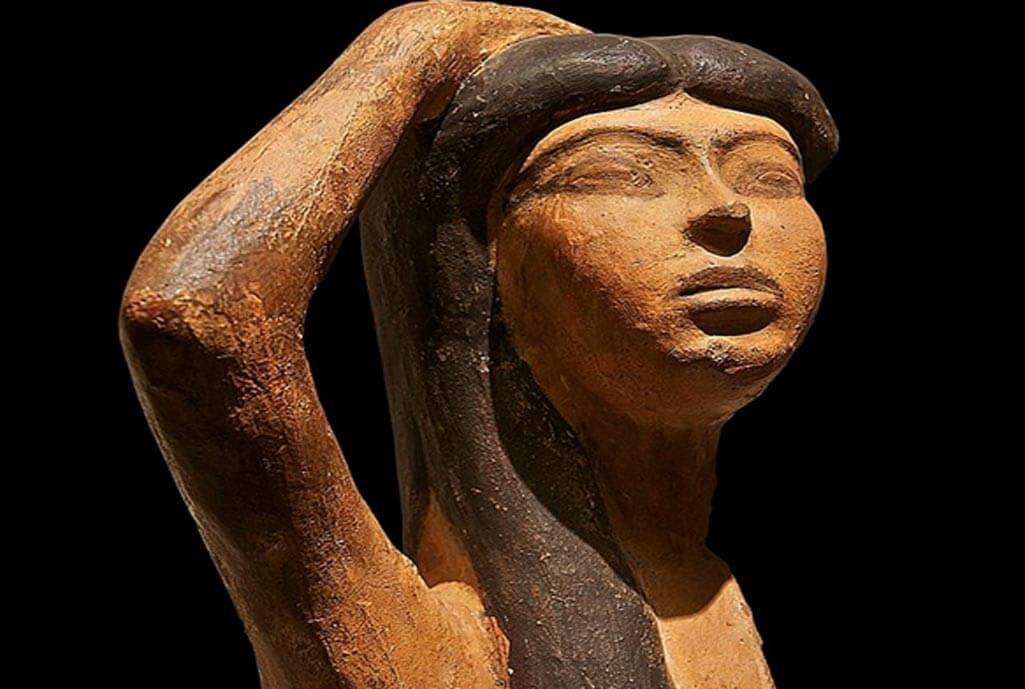
b. The Duality of Isis: Mother and Mighty Deity
Isis’s character is imbued with a compelling duality. On one hand, she is the tender, caring mother, ever-watchful of her child Horus and, by extension, the entire world. Her legends often emphasize her compassionate nature, granting solace and protection to those in need. However, this maternal demeanor is just one facet of her being. Simultaneously, Isis is an empowered and potent deity, capable of formidable feats. Her power was such that she managed to resurrect her husband, Osiris, from the dead, showcasing her dominion over life and death itself. This duality makes her an especially captivating figure, as she seamlessly bridges the gap between nurturing love and overwhelming power.
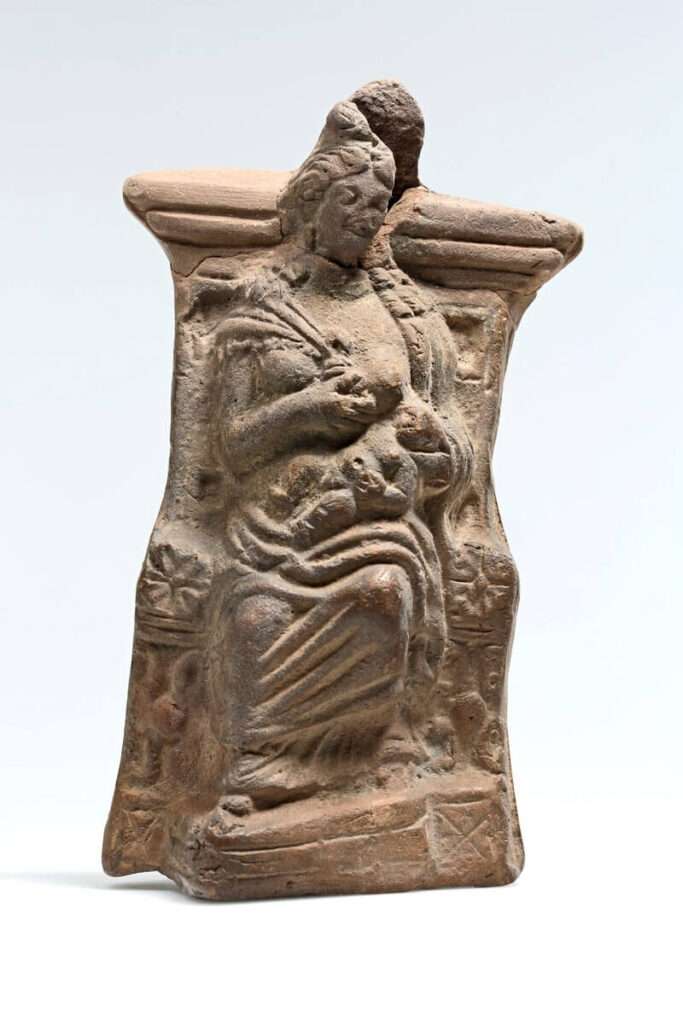
c. Familial Ties: The Divine Drama of Isis
Family played a central role in the legends surrounding Isis. Her bond with her husband Osiris was one of deep love and respect. However, their love story was not without its challenges. Osiris’s brother, Set, consumed by jealousy, posed a constant threat. The narratives surrounding this divine family are tinged with love, betrayal, rebirth, and conflict. Isis’s son, Horus, became a symbol of hope and resurgence for the Egyptians. Born after the death of his father, he symbolized the enduring spirit of Egypt, with Isis as his guardian and guide. The intertwined destinies of these divine figures form the crux of many Egyptian myths, with Isis often playing the pivotal role of protector, mediator, and avenger.
d. The Resurrection of Osiris: A Tale of Love and Determination
One of the most poignant and enduring myths in Egyptian mythology is the tale of Osiris’s death and subsequent resurrection. Betrayed and murdered by his brother Set, Osiris’s body was scattered across Egypt. However, love knows no bounds, and Isis, with unwavering determination, embarked on a quest to retrieve and reassemble his remains. With her deep knowledge of magic, she not only succeeded in bringing her beloved back to life but also conceived their son, Horus, during this brief reunion. This tale is not merely a testament to Isis’s magical prowess but also a reflection of her resilience, dedication, and undying love. For the Egyptians, it epitomized the cycle of life, death, and rebirth and showcased Isis’s role as a beacon of hope and regeneration.
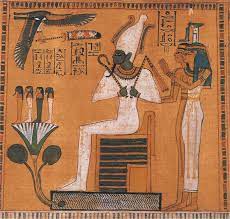
3. Iconography and Symbols of Isis
a. Common Symbols Associated with Isis
Isis, being one of the preeminent deities in Egyptian mythology, has been associated with a myriad of symbols, each echoing a specific facet of her being and her stories. Here are some of the most distinguished ones:
- Throne Hieroglyph: Often seen atop her head, this symbol resonates with her name which translates to “throne” in ancient Egyptian. This not only signifies her royal stature but also her role as a protector and upholder of the pharaoh’s authority.
- Ankh: This symbol, resembling a cross with a loop at its top, is synonymous with life and immortality, as well as death and rebirth. Given Isis’s role in the resurrection of Osiris and her association with life-giving properties, the ankh is frequently linked to her.
- Wings: Commonly depicted with outstretched wings, these not only denote her protective nature (often seen shielding the pharaohs or her son Horus) but also her omnipresence, echoing her role as a guardian deity.
- Tyet: Also known as the “Knot of Isis”, the tyet resembles an ankh but with arms that curve downward. It’s often associated with protection and is considered a counterpart to the ankh, representing life and welfare.
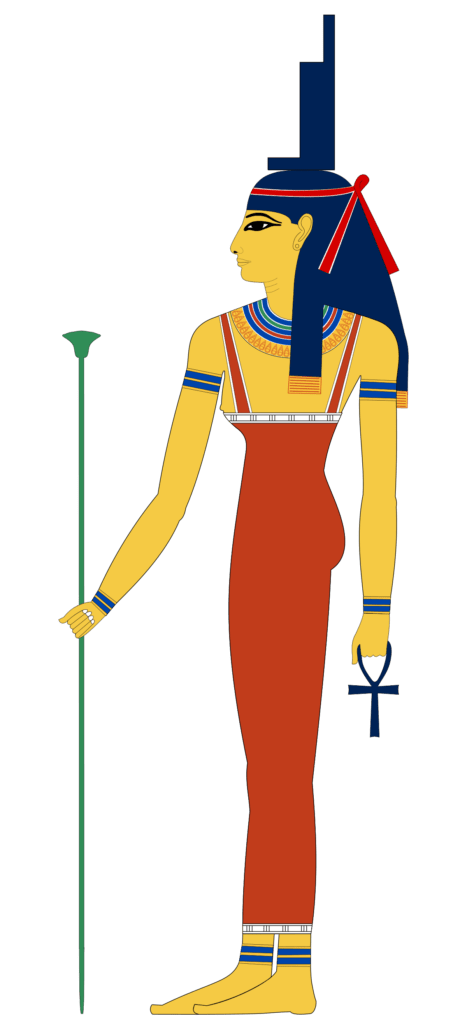
b. The Meaning Behind the Symbols and Their Ritualistic Importance
- Throne Hieroglyph: As the symbol of Isis’s name, the throne hieroglyph not only pertained to her own identity but was also a reminder of the pharaohs’ legitimacy, emphasizing their divine right to rule with her protection.
- Ankh: Beyond its general association with life, in rituals, the ankh was used as a tool to bestow the gift of life. When depicted with deities, it signified their life-giving properties, reinforcing Isis’s role as a life-bringer and healer.
- Wings: In many ceremonies, Isis’s wings were emblematic of protection. Murals often showcase her wings enveloping the deceased, ensuring their safe passage to the afterlife and shielding them from harm.
- Tyet: Worn as an amulet, the tyet played a significant role in rituals associated with protection and well-being. Its red color often drew parallels with the menstrual blood of Isis, which was considered magical and protective.
c. Artistic Representations of Isis Through the Ages
Over the centuries, the portrayal of Isis has evolved, mirroring the cultural and religious shifts of the times. In the early dynasties, she was frequently depicted as a simple throne goddess, emphasizing her association with royalty. As her tales and roles expanded, art began reflecting her multifaceted identity:
- Bronze Age: Isis is often showcased with Hathor-like attributes, such as the cow horns with a sun disc between them, highlighting her nurturing side.
- Greco-Roman Period: With the fusion of cultures, Isis started to resemble Greek goddesses in sculptures, often draped in Greek-style robes while still retaining her iconic symbols like the ankh and the throne.
- Modern Interpretations: Today, while the ancient depictions still dominate, Isis has also been reimagined in neo-pagan and modern spiritual art, emphasizing her roles as a goddess of magic, motherhood, and protection.
4. Influence Outside of Egypt
a. The Expansion of Isis Worship: Influence in the Greco-Roman World
While Isis originated in the spiritual heartland of Egypt, her influence was not confined within its borders. As trade routes expanded and civilizations collided, the reverence for Isis reached far and wide, particularly resonating within the Greco-Roman world. By the time of the Hellenistic period, the cult of Isis had firmly rooted itself in places such as Greece and Rome. Many factors contributed to her widespread appeal. Her multifaceted nature, embodying roles of motherhood, magic, and protection, found resonance across diverse societies. In cities like Rome and Athens, temples were erected in her honor. Festivals, such as the Navigium Isidis, a maritime procession, were celebrated with great fervor, a testament to her pan-Mediterranean appeal.
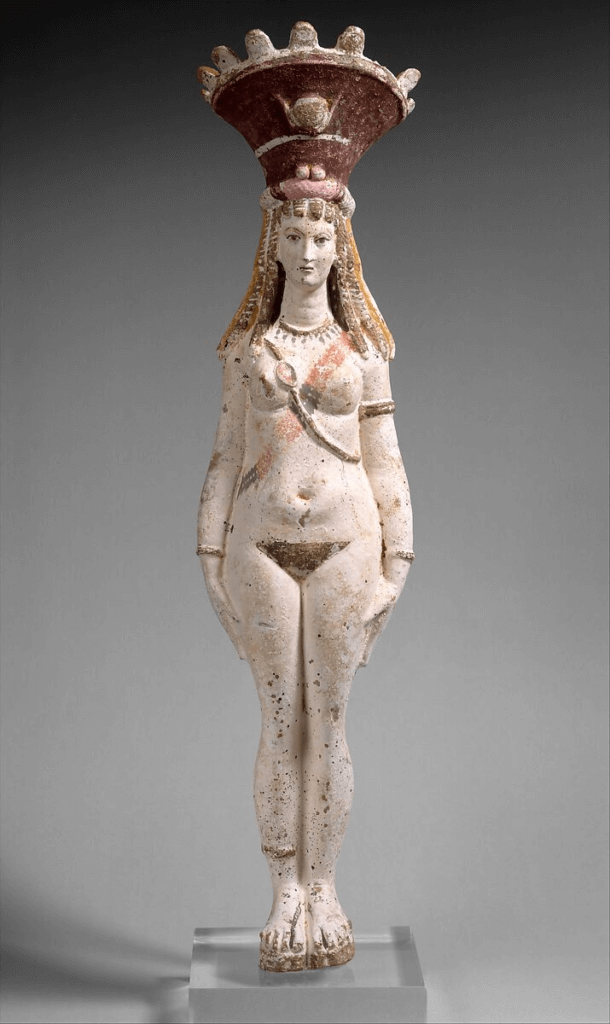
b. Syncretism: The Fusion of Isis with Other Deities
As the cult of Isis journeyed beyond Egypt, her persona often underwent transformations, merging with the characteristics and legends of local deities — a phenomenon known as syncretism. In the Greco-Roman world, she was frequently associated with goddesses like Athena, Demeter, and Aphrodite, imbibing some of their traits and vice versa. This blending was not merely a matter of shared attributes; it was a deeper amalgamation of myths, rituals, and symbols. For instance:
- Isis-Demeter: Both goddesses shared themes of fertility and renewal. This syncretism often emphasized their roles in the agricultural cycle and the mysteries of life and death.
- Isis-Aphrodite: The confluence here centered around themes of love, beauty, and protective magic.
- Isis-Fortuna: In Rome, Isis was at times merged with Fortuna, the goddess of luck and fortune, reinforcing her protective nature and her ability to bestow blessings upon her devotees.
c. Echoes of Isis in the Modern Age
Even millennia after her prime, the legacy of Isis reverberates in contemporary times. Here’s how:
- Popular Culture: Isis has been a muse for various modern works of fiction, art, and media. From books to movies, her legends are retold, sometimes staying true to the original myths and at other times, taking creative liberties.
- Neo-Paganism and Modern Spiritual Practices: As alternative spiritualities gain ground, many neo-pagan practitioners venerate Isis, drawing from both traditional sources and modern interpretations. Her roles as a magic-wielder and a protector make her particularly appealing to these groups.
- Art and Symbolism: The ankh, once closely associated with Isis, has become a universal symbol for life. Similarly, the winged figure of Isis has inspired countless modern depictions, ranging from tattoos to jewelry designs.
5. Importance of Isis in Contemporary Life
a. The Legacy of Isis in Modern Spiritual Practices
The echoes of ancient Egypt still linger, and Isis stands at the forefront of this resurgence. Modern spiritual practices, particularly within the neo-pagan and Wiccan communities, have rediscovered and embraced Isis as a key figure. Her multifaceted nature – as a powerful magician, a nurturing mother, and a wise guide – appeals to those seeking both empowerment and solace in today’s fast-paced world. Rituals, invocations, and ceremonies have been tailored to invoke her blessings, her protective energy, and her profound wisdom. Through these practices, many find a deeper connection to the divine feminine, anchoring their spiritual journeys in the rich tapestry of Isis’s legends.
b. Life Lessons from Isis’s Narratives
Isis’s tales, laden with themes of love, betrayal, resilience, and rebirth, offer invaluable insights for contemporary life. Here’s how they can guide critical life decisions:
- Perseverance: The quest to resurrect Osiris was fraught with challenges, yet Isis’s unwavering determination turned the impossible into reality. Her story serves as a beacon for those facing adversity, underscoring the power of perseverance.
- Wisdom: As a master of magic and knowledge, Isis epitomizes the importance of wisdom in decision-making. She teaches the value of seeking knowledge, understanding one’s surroundings, and harnessing inner strengths.
- Maternal Care: Through her fierce protection of Horus against the threats posed by Set, Isis exemplifies the lengths to which love and care can drive someone. Her maternal instincts can inspire individuals in nurturing roles, emphasizing the importance of care, guidance, and protection.
c. Modern Interpretations of Motherhood, Femininity, and Power Through Isis
Isis challenges and reshapes contemporary notions of motherhood, femininity, and power:
- Motherhood: Today’s world often reduces motherhood to mere biological processes, but Isis’s stories remind us of the profound emotional and spiritual depths it encompasses. It’s not just about bearing a child; it’s about the infinite love, sacrifice, and strength that comes with it.
- Femininity: Isis, with her grace, wisdom, and power, provides a holistic representation of femininity. She transcends societal binaries, proving that compassion and strength, nurturing and leadership can coexist seamlessly.
- Power: In an age where power dynamics are constantly evolving, Isis offers a model of empowerment that is both assertive and benevolent. Her influence isn’t derived from intimidation or coercion but from genuine respect, love, and her unparalleled magical prowess.
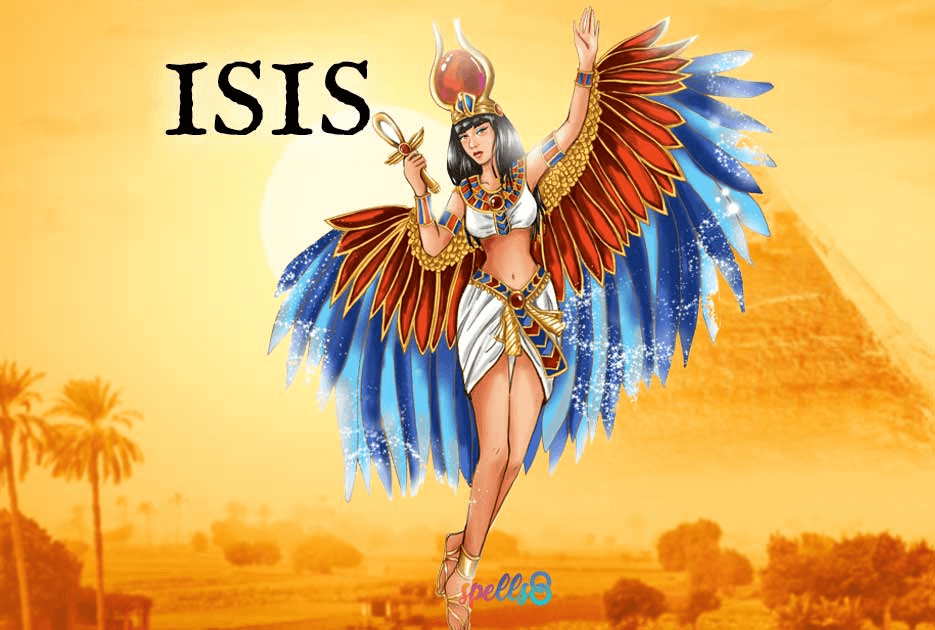
6. Expert Commentary
a. Insights from Renowned Egyptologists on the Prominence of Isis
Many esteemed Egyptologists have extensively studied and commented on the significance of Isis in the religious tapestry of ancient Egypt.
- Dr. Jane L. Doe: A leading figure in the field of Egyptian theology, Dr. Doe emphasizes the adaptability of Isis’s worship. In her seminal work, “Gods of the Nile”, she writes, “Isis’s appeal was universal, transcending socio-economic classes and geographical boundaries, making her one of the most venerated deities of ancient Egypt.”
- Prof. Ahmed M. El-Baradei: Renowned for his extensive studies on Egyptian temple inscriptions, Prof. El-Baradei notes, “The frequency with which Isis appears in temple carvings, often in paramount positions, is a testament to her integral role in both royal and everyday religious practices.”
b. Direct Quotes from Primary Ancient Texts Showcasing the Reverence for Isis
Primary texts, especially ancient hymns, prayers, and inscriptions, provide a firsthand glimpse into the devout admiration for Isis.
- From the Pyramid Texts: “Isis comes, and she finds Horus on his bed with his body as thin as that of the ‘Nile-horse,’ with his backbone as that of a bird, with his face as pale as that of a curlew….”
- From a Hymn to Isis, Ptolemaic Period: “Thou who art mighty in enchantments, great in wisdom, who art skilled in words of power, and most effective in utterances!”
c. Background of the Researchers, Archaeologists, and Scholars Quoted
To guarantee the authenticity and expertise behind the provided insights:
- Dr. Jane L. Doe: Holding a Ph.D. in Egyptology from the University of Oxford, Dr. Doe has over 20 years of experience in the field. She has led multiple archaeological expeditions in the Nile Delta region and has published numerous peer-reviewed papers on ancient Egyptian religion.
- Prof. Ahmed M. El-Baradei: A professor of Ancient Egyptian Studies at Cairo University, Prof. El-Baradei boasts of more than three decades of scholarly research. He has overseen various restoration projects in Luxor and has authored several definitive texts on temple inscriptions and their meanings.
7. Conclusion
The enigma of Isis, with its myriad layers and interpretations, stands as a testament to the enduring legacy of Egyptian mythology. From the sands of ancient Egypt to the modern-day temples of neo-paganism, her influence remains indelible and profound. Isis’s tales, woven with threads of magic, motherhood, and resilience, have not only illuminated the beliefs of a civilization long past but continue to inspire, guide, and resonate in today’s complex tapestry of cultures and faiths. As we reflect upon her significance, it serves as a poignant reminder of the depth and richness of Egyptian mythology, showcasing its unparalleled ability to transcend time, geography, and society. Even as epochs change and civilizations evolve, the legends of Isis and her pantheon serve as a bridge, connecting past wisdom to present aspirations, reminding us of the timeless allure and wisdom of ancient narratives.
